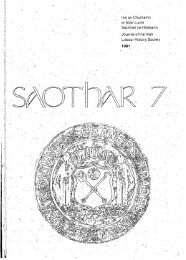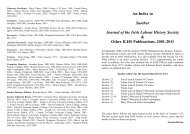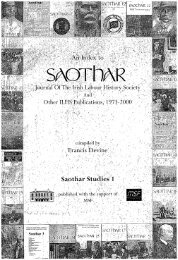28 SAOTHAR 13poor rates. In normal circumstances this group would not have been resident in Ireland during theseperiods. Now they had to be catered for despite the rapidly diminishing food supplies in the poorestunions. This, coupled with the potato failure, exacerbated the migrant's situation and in the circle ofmisery he was forced into debt, procuring food mainly through credit.While the combination of reduced demand for migrant labour and the failure of the potato cropbrought distress to a head in 1879, these problems had begun to manifest themselves in the previoustwo years. Many Mayo and Donegal migrants in 1878-9 had to have their fares forwarded to them inBritain to bring them home. 19 The safety valve against crop failures, which seasonal migration had beenin the past, was no longer as dependable after 1879, with disastrous consequences for manycommunities. On Achill Island the average annual remittances of £10,000 from migration slumped to£ 1,000 in 1879. Throughout the west the net loss in migrant earnings for 1879 was £250,000, or onethirdof the normal total remittances.20 This devastating drop in income occurred at a time when theLand League was in its formative stages, and certainly helped harness migrants' support for the Mayomovement. There was little alternative for the labourers, for this financial loss meant poverty fromSeptember to the following spring, with the only fall back being credit and the poor law ..Besides relieving the burden on poor law unions, seasonal migration had a major impact on twofurther features of society. It was an important component in curtailing distress among the labouringclasses and it acted as a means of controlling social order within the community. As Kennedy hasindicated, the relative absence of agrarian violence in west Ulster in the. second half of the nineteenthcentury can be partly attributed to the safety valve of seasonal migration. 21 The same is true of Mayo,Galway, and Roscommon; agrarian crime became serious in these counties during 1879-81 and 1885-86 only. These periods coincide with record decreases in migrant remittances and a major reductionin the demand for labour. Consequently social order was balancing tenuously on the fortunes of theseasonal trends, as the primary factor which kept the tenants placated and law abiding was theremittances from seasonal migration. Success in the maintenance of social order in 1879-81 and 1885-86 was achieved only in those areas where landlords provided their tenants with rent reductions.Outside of remittances, the landlord was the only source who could directly assist these tenants andmaintain peace within the community.22Land agitation produced a militancy within Irish agrarian society, especially concerning landlordtenantrelations, which had not been previously evident. Reductions in remittances from Britainresulted in migrants' involvement in the agitation, as was evident with the Dillon estate in east Mayoand Roscommon when the 5,000 tenants became involved in the Plan of Campaign. Such an analysiswould reinforce the conclusion that seasonal migration was a direct consequence of the economicpolicies undertaken by the landlords, as the latter continued to extract from holdings rents well in excessof what they were capable of producing. 23 Farm rentals were inflated to an artificial level, for it wasthe level of English rather than Irish labourers' wages which were maintaining rentals at the artificialrate. .Seasonal migration played no small part in the extensive use of marginal lands for agriculturalproduction. This is seen in the un viable structure of the holdings on the Dillon estate - eighty-sevenper cent of holdings had a valuation of under £4. Large scale migration to Britain and a readily availablesupply of bog land for reclamation had played a major part in increasing the rent rolls of manylandlords. 24 The extended period of agricultural depression in the mid-1880s created further problems,with tenants adopting a more aggressive approach towards their landlords. The landlords were seen asthe only source of relief in that they had the power to reduce rents.25Despite their tough conditions migrants remained unorganised. Throughout the nineteenth centurylittle attempt was made to secure better wages and conditions for them. While labourers' organisationswere established from the 1870s, they tended to be confined mainly to Munster and south Leinster,providing little hope for the agricultural m igrants of the west. In 1873, the English National AgriculturalLabourers Union formed a branch in Ireland arising out of an increased demand for Irish agriculturallabour in Britain, brought about ironically by English agricultural labour unrest. English labourers had
A PASSAGE TO BRITAIN 29established the union to secure better wages and conditions and had withdrawn their labour fromEnglish farmers. The impact of their action was, however, minimised by the continuing migration ofIrish labourers. Not only were the Irish prepared to carry out the functions of the English labourers, butthey were prepared to accept a lower wage. To curtail this threat the union established a branch inIreland under the chairmanship of the west Cork land agitator, P.P. Johnstone.26There are a number of reasons for the'union's failure to become a force in Ireland and secure itsobjectives. It was more concerned with curtailing migration than in redressing the grievances of Irishagricultural labourers. No concrete attempt was made to improve migrants' conditions in England andScotland. As the union confined its operations to west Cork, where migration was primarily of aninternal nature, it failed to address the exodus to Britain from the main centres of Mayo, Roscommonand west Donegal.No unity in organisation is evident amongst the migrants in the 1880s, despite persistent complaintsof low wages and inadequate accommodation. In the nineteenth century the ganger was the onlyorganising force among the migrants, but he did little or nothing to protect their living standards orwages when in Britain. His concern lay in organising a sufficient labour force for the farmer. Z1 It proveddifficult, ifnot impossible, to secure unity of purpose from within the ranks of subsistence dwellers whoneeded money to pay their rent. With the decline in demand for migrants in the 1880s, the possibilityof organising to secure better conditions became more remote. The various agrarian organisations ofthe nineteenth century, including the Land League, failed to incorporate any of the migrants' grievancesinto their programme. Circumstances altered briefly, if dramatically, during the Great War, bringingabout a new demand for Irish migrant labour in Britain. Under the auspices of the United Irish League,the Migratory Labourers Union was established. Its main geographical base was in west Donegal, Errisand Achill. It was still not until the 1930s, that the demands for better wages and accommodationbecame enshrined in statutory law.28Due to their lack of organisation, the conditions and pri vations of the migrants both at home and inBritain were seldom highlighted in the nineteenth century. They did come to public notice duringperiods of acute distress and tragedy, such as in June 1894 when thirty-two Achill migrants weredrowned near Weslport harbour. The very nature of the migrants' livelihood made them morevulnerable to economic and agricultural change, depending on fluctuations in crops to a far greaterextent than any other sector. What is clear is that the less well off tenant farmers availed themselvesof seasonal migration as an escape route from distress or the failure of the potato crop in the same mannerthat their more prosperous counterparts used emigration. When the potato failure reached crisisproportions in 1882, with crop yields per acre of only 1.8 tons in Mayo, 1.9 in Donegal and 2.1 inRoscommon, there resulted a dramatic though temporary increase in the number of people going toBritain.29 It also corresponded with increases in emigration from these regions. On those occasionswhen a tenant obtained meal or seed potatoes on credit from shopkeepers or from the government duringperiods of distress, as in 1879-81 and the early 1890s, he found the only avenue open to him to repaythe loans was seasonal migration. It was under these circumstances that sharp increases in seasonalmigration occurred in the years immediately following those of great distress. 3DThe agricultural depression and changing structure of British agriculture in the last qUaJ1er of thecentury brought a terminal decline in seasonal migration. Machinery became more widespread and costeffective. Machines, such as the Dray's Hussey, cost only £25, against daily wages of £4 - £5. 31 Whilemachinery had been introduced into British agriculture in the 1850s, seasonal migration received a stayof execution because of the initial cost in purchasing the machines. However it was inevitable thatmechanisation would eventually result in seasonal demand being unable to sustain previous levels ofmigration. Only in 1884 did a government report officially acknowledge what had been realised forover a decade - that the introduction of machinery was a primary catalyst in the demise of migrantdemand.Seasonal migration was an inherent feature of the social and economic structure of the west of
- Page 1 and 2: JOURNAL OF THE IRISH LABOUR HISTORY
- Page 3 and 4: ContentsPageEditorial: Labour Histo
- Page 5 and 6: EDITORIAL 3freedom to participate i
- Page 7 and 8: CorrespondenceThe Irish Labour Part
- Page 9 and 10: ; ~ ; ,The Decline and Fall of Donn
- Page 11 and 12: THE DECLINE AND FALL OF DONNYBROOK
- Page 13 and 14: THE DECLINE AND FALL OF DONNYBROOK
- Page 15 and 16: ·' THE DECLINE AND FALL OF DONNYBR
- Page 17 and 18: THE DECLINE AND FALL OF DONNYBROOK
- Page 19 and 20: THE DECLINE AND FALL OF DONNYBROOK
- Page 21 and 22: THE DECLINE AND FALL OF DONNYBROOK
- Page 23 and 24: THE DECLINE AND FALL OF DONNYBROOK
- Page 25 and 26: ,'-,;-''''.A PASSAGE TO BRITAIN 23C
- Page 27 and 28: A PASSAGE TO BRITAIN 25only in the
- Page 29: A PASSAGE TO BRITAIN 27clothing._De
- Page 33 and 34: ;:-.",.- .. .", ...... '.:. '
- Page 35 and 36: LOUIE BENNETI 33feminist movement w
- Page 37 and 38: :... ~: ."
- Page 39 and 40: -.- '.LOUlE BENNETT 37While there i
- Page 41 and 42: LOUIE ~ENNEIT 39Xl's encyclical Qua
- Page 43 and 44: LOUIE BENNEIT 41Bennett's own relat
- Page 45 and 46: LODIE BENNETT 43109; IWWU resolutio
- Page 47 and 48: Essays in ReviewCosherers, Wanderer
- Page 49 and 50: ••• .".'. >. '~"ESSA YS IN RE
- Page 51 and 52: ESSAYS IN REVIEW 49ConnolIy:Myth an
- Page 53 and 54: ESSAYS IN ~EVIEW 51tion' in the Int
- Page 55 and 56: ESSAYS IN REVIEW53International:'I
- Page 57 and 58: REVIEWScontroversy is real history.
- Page 59 and 60: REVIEWSJoe Monks was among the earl
- Page 61 and 62: REVIEWSnolly-Column Song','Proudly
- Page 63 and 64: REVIEWSresulting from the arrival o
- Page 65 and 66: REVIEWS,63the book by means of an a
- Page 67 and 68: REVIEWSlogue, it is hardly surprisi
- Page 69 and 70: The Team For All Workers ...CULIAIB
- Page 71 and 72: ESSAYS 69mission and moral refonn.l
- Page 73 and 74: .. ...... ~.~ -~ .'- '.ESSAYS. 71fr
- Page 75 and 76: ESSAYS 73claimed authority but whic
- Page 77 and 78: ESSAYS 75provided the basis for soc
- Page 79 and 80: ESSAYS 779. For comparisons see E.T
- Page 81 and 82:
ESSAYS 7952. Annals of Christ Churc
- Page 83 and 84:
ESSAYS' 81Fianna Fail and the Worki
- Page 85 and 86:
ESSAYS 83Eireann in 1925 visibly di
- Page 87 and 88:
ESSAYS 85recognition of the impract
- Page 89 and 90:
ESSAYS 871970, it created the condi
- Page 91 and 92:
ESSAYS89The Irish Immigrants' Contr
- Page 93 and 94:
ESSAYS" 91Although anti -Catholic p
- Page 95 and 96:
ESSAYS 93McCowie played a key role
- Page 97 and 98:
:. -,,'.' ',. .~.,:.ESSAYS 95Althou
- Page 99 and 100:
ESSAYS 97young girl of their own ba
- Page 101 and 102:
SourcesIrish Labour History Society
- Page 103 and 104:
SOURCES 101INovember, 1971 to no. 1
- Page 105 and 106:
SOURCES 103would claim credit for t
- Page 107 and 108:
SOURCES105Sources for Irish Labour
- Page 109 and 110:
SOURCES 107NorthWest Archives and L
- Page 111 and 112:
SOURCES 109In 1966 the Finnish gove
- Page 113 and 114:
TURNINGANEWLEAFThe CPSSUis the larg
- Page 115 and 116:
REMINISCENCE 113us due to my politi
- Page 117 and 118:
REMINISCENCE 115when Jim was presen
- Page 119 and 120:
REMINISCENCE 117of Dail Eireann. 17
- Page 121 and 122:
REMINISCENCE 119NotesThe above arti
- Page 123 and 124:
DOCUMENT STUDY 121James Connolly in
- Page 125 and 126:
DOCUMENT STUDY123SOCIAL DEMOCRATIC
- Page 127 and 128:
DOCUMENT STUDY 125proletariat of th
- Page 129 and 130:
DOCUMENT STUDY 127the support of Je
- Page 131 and 132:
DOCUMENT STUDY 12926. The Workers'
- Page 133 and 134:
131BibliographyA Bibliography of Ir
- Page 135 and 136:
BIBLIOGRAPHY 133Compton, P.A. Demog
- Page 137 and 138:
BIBLIOGRAPHY 135Levine, I. and Madd
- Page 139 and 140:
BIBLIOGRAPHY 137Turner, M. 'Towards
- Page 141 and 142:
BIBLIOGRAPHY 1394. Land and Agricul
- Page 143 and 144:
BIBLIOGRAPHY 141Clogher Record12 (2
- Page 145 and 146:
BIBLIOGRAPHY 143Political Research
- Page 147 and 148:
BIBLIOGRAPHY 145Pres, 1987.O'Brien,
- Page 149 and 150:
147Notes on Contributorsf onathanBe
- Page 151 and 152:
1901: Ireland's first general union
- Page 153 and 154:
ELECTRICAL TRADES UNION .Establishe





